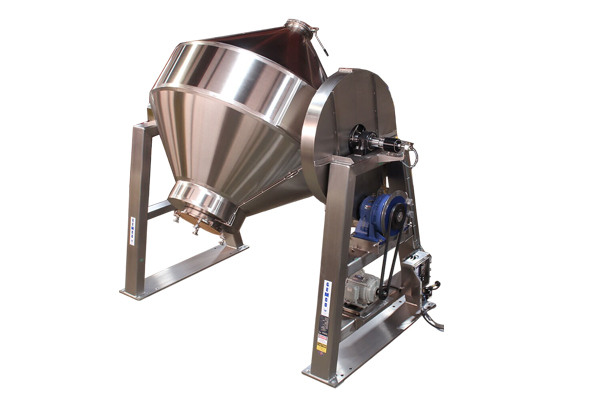WORKING
This type of mixer is designed in such a way that the vessel imparts movement to the material of mixing by tilting the powder until the angle of surface exceeds the angle of repose. Thus powder bulk or particles slide and get mixed in the vessel. It rotates on central shaft. Shape of cylinder comes in two truncated cones joined together by cylinder section. A tight closing lid of the fast closing type for feeding material and a discharge butterfly valve at the other end of the unit which also renders a perfect tightness. Baffles are provided in bigger unit for intense mixing.
During the process of mixing particles of powder of mixing particles of powder hit each other and wall of the mixer resulting mixing action. However speed of mixture is very important. It should run at critical speed. Too high or too low speed will definitely affect the mixing process. The blender is recommended preferably when the products to be mixed have a similar density and particular size as well as no lumping properties. Over loading of mixer with powder material should be avoided. There should be sufficient room for powder to move in drum. Critical time for mixing can be set by withdrawing the samples from mixer at interval of time and analyzing it for homogeneity.
CONSTRUCTION
Double cone blenders used in India for dry powder mixing are typically constructed from high-quality stainless steel, ensuring a smooth, polished interior and exterior for easy cleaning and GMP compliance. They consist of two conical sections welded to a central cylindrical section, allowing for effective blending of dry powders. The axis of rotation is perpendicular to the cone axis, with the driving motor often located on a lateral support.
CONSTRUCTION MATERIALS
Stainless Steel :
High-quality stainless steel is commonly used for all parts that come into contact with the product, ensuring hygiene and preventing corrosion.
Carbon Steel :
The support structures and some non-critical components may be made of carbon steel.
High Homogeneity :
Double cone blenders are designed to achieve high levels of homogeneity in dry powder mixtures.
Easy Cleaning :
The polished surfaces and lack of sharp edges make cleaning easy, often with manual or automatic CIP (Cleaning In Place) systems.
Various Structures :
Different structures, including intensifier bars, are available to suit various mixing needs.
Suitable for GMP :
The design and construction of double cone blenders often meet GMP (Good Manufacturing Practice) requirements.
ELABORATION
Material Loading :
Dry powders or granules are loaded into the double-cone blender through a loading aperture, often using vacuum conveying or manual feeding.
Rotation :
The double-cone container is rotated, causing the material to move and mix within the chamber.
Conical Shape :
The conical shape at both ends of the container ensures that the material doesn't settle in any dead areas, promoting uniform mixing.
Mixing Mechanism :
The rotation causes the material to tumble, collide, and mix, ensuring a homogenous blend.
Discharge :
The mixture is discharged through a hermetically sealed butterfly valve, either manually or automatically.
Safety Features :
Many double cone blenders include safety features like safety gates and interlocks to prevent operator access when the mixer is rotating.
FUNCTIONALITY
Homogeneous Mixing :
The double cone blender is designed to create a uniform mixture of dry powders and granules, ensuring consistent quality.
Material Distribution :
The conical shape helps distribute materials evenly, preventing dead zones and ensuring thorough mixing.
Easy Discharge :
The conical design facilitates easy and efficient discharge of the blended material.
Various Applications :
Double cone blenders are used in a wide range of industries, including food (for mixes, spices, etc.), pharmaceuticals (for tablets and powders), chemicals (for various compounds), and cosmetics (for powders and creams).
CONSTRUCTION NAD FEATURES
Conical Shape :
The double cone shape is crucial for the mixing process, ensuring even distribution of materials.
Stainless Steel Construction :
Often made of stainless steel for hygiene and durability.
Safety Features :
May include safety guards and limit switches to ensure safe operation.
Vacuum Conveying :
Some double cone blenders can be equipped with vacuum conveying systems for efficient material loading, especially for larger volumes.
GMP Compliance :
Many blenders are designed to meet GMP (Good Manufacturing Practice) standards, which are important for pharmaceutical and food industries.
